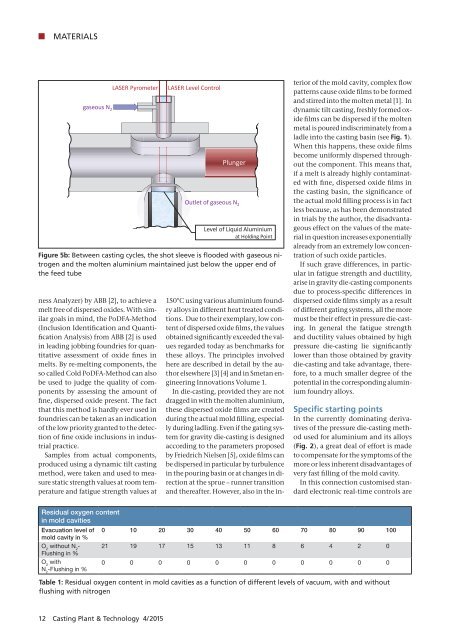CPT International 04/2015
The leading technical journal for the global foundry industry – Das führende Fachmagazin für die weltweite Gießerei-Industrie
The leading technical journal for the
global foundry industry – Das führende Fachmagazin für die
weltweite Gießerei-Industrie
Create successful ePaper yourself
Turn your PDF publications into a flip-book with our unique Google optimized e-Paper software.
K MATERIALS<br />
gaseous N 2<br />
LASER Pyrometer<br />
ness Analyzer) by ABB [2], to achieve a<br />
melt free of dispersed oxides. With similar<br />
goals in mind, the PoDFA-Method<br />
(Inclusion Identification and Quantification<br />
Analysis) from ABB [2] is used<br />
in leading jobbing foundries for quantitative<br />
assessment of oxide fines in<br />
melts. By re-melting components, the<br />
so called Cold PoDFA-Method can also<br />
be used to judge the quality of components<br />
by assessing the amount of<br />
fine, dispersed oxide present. The fact<br />
that this method is hardly ever used in<br />
foundries can be taken as an indication<br />
of the low priority granted to the detection<br />
of fine oxide inclusions in industrial<br />
practice.<br />
Samples from actual components,<br />
produced using a dynamic tilt casting<br />
method, were taken and used to measure<br />
static strength values at room temperature<br />
and fatigue strength values at<br />
LASER Level Control<br />
Plunger<br />
Outlet of gaseous N 2<br />
Level of Liquid Aluminium<br />
at Holding Point<br />
Figure 5b: Between casting cycles, the shot sleeve is flooded with gaseous nitrogen<br />
and the molten aluminium maintained just below the upper end of<br />
the feed tube<br />
150°C using various aluminium foundry<br />
alloys in different heat treated conditions.<br />
Due to their exemplary, low content<br />
of dispersed oxide films, the values<br />
obtained significantly exceeded the values<br />
regarded today as benchmarks for<br />
these alloys. The principles involved<br />
here are described in detail by the author<br />
elsewhere [3] [4] and in Smetan engineering<br />
Innovations Volume 1.<br />
In die-casting, provided they are not<br />
dragged in with the molten aluminium,<br />
these dispersed oxide films are created<br />
during the actual mold filling, especially<br />
during ladling. Even if the gating system<br />
for gravity die-casting is designed<br />
according to the parameters proposed<br />
by Friedrich Nielsen [5], oxide films can<br />
be dispersed in particular by turbulence<br />
in the pouring basin or at changes in direction<br />
at the sprue – runner transition<br />
and thereafter. However, also in the interior<br />
of the mold cavity, complex flow<br />
patterns cause oxide films to be formed<br />
and stirred into the molten metal [1]. In<br />
dynamic tilt casting, freshly formed oxide<br />
films can be dispersed if the molten<br />
metal is poured indiscriminately from a<br />
ladle into the casting basin (see Fig. 1).<br />
When this happens, these oxide films<br />
become uniformly dispersed throughout<br />
the component. This means that,<br />
if a melt is already highly contaminated<br />
with fine, dispersed oxide films in<br />
the casting basin, the significance of<br />
the actual mold filling process is in fact<br />
less because, as has been demonstrated<br />
in trials by the author, the disadvantageous<br />
effect on the values of the material<br />
in question increases exponentially<br />
already from an extremely low concentration<br />
of such oxide particles.<br />
If such grave differences, in particular<br />
in fatigue strength and ductility,<br />
arise in gravity die-casting components<br />
due to process-specific differences in<br />
dispersed oxide films simply as a result<br />
of different gating systems, all the more<br />
must be their effect in pressure die-casting.<br />
In general the fatigue strength<br />
and ductility values obtained by high<br />
pressure die-casting lie significantly<br />
lower than those obtained by gravity<br />
die-casting and take advantage, therefore,<br />
to a much smaller degree of the<br />
potential in the corresponding aluminium<br />
foundry alloys.<br />
Specific starting points<br />
In the currently dominating derivatives<br />
of the pressure die-casting method<br />
used for aluminium and its alloys<br />
(Fig. 2), a great deal of effort is made<br />
to compensate for the symptoms of the<br />
more or less inherent disadvantages of<br />
very fast filling of the mold cavity.<br />
In this connection customised standard<br />
electronic real-time controls are<br />
Residual oxygen content<br />
in mold cavities<br />
Evacuation level of 0 10 20 30 40 50 60 70 80 90 100<br />
mold cavity in %<br />
O 2<br />
without N 2<br />
- 21 19 17 15 13 11 8 6 4 2 0<br />
Flushing in %<br />
O 2<br />
with<br />
N 2<br />
-Flushing in %<br />
0 0 0 0 0 0 0 0 0 0 0<br />
Table 1: Residual oxygen content in mold cavities as a function of different levels of vacuum, with and without<br />
flushing with nitrogen<br />
12 Casting Plant & Technology 4/<strong>2015</strong>


















